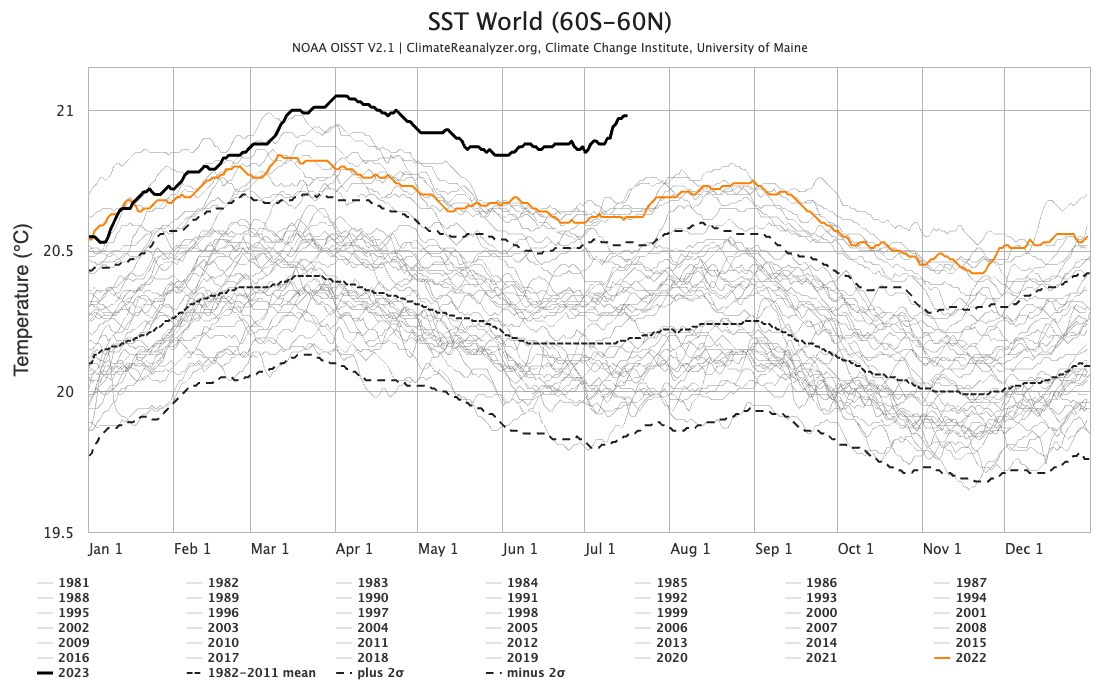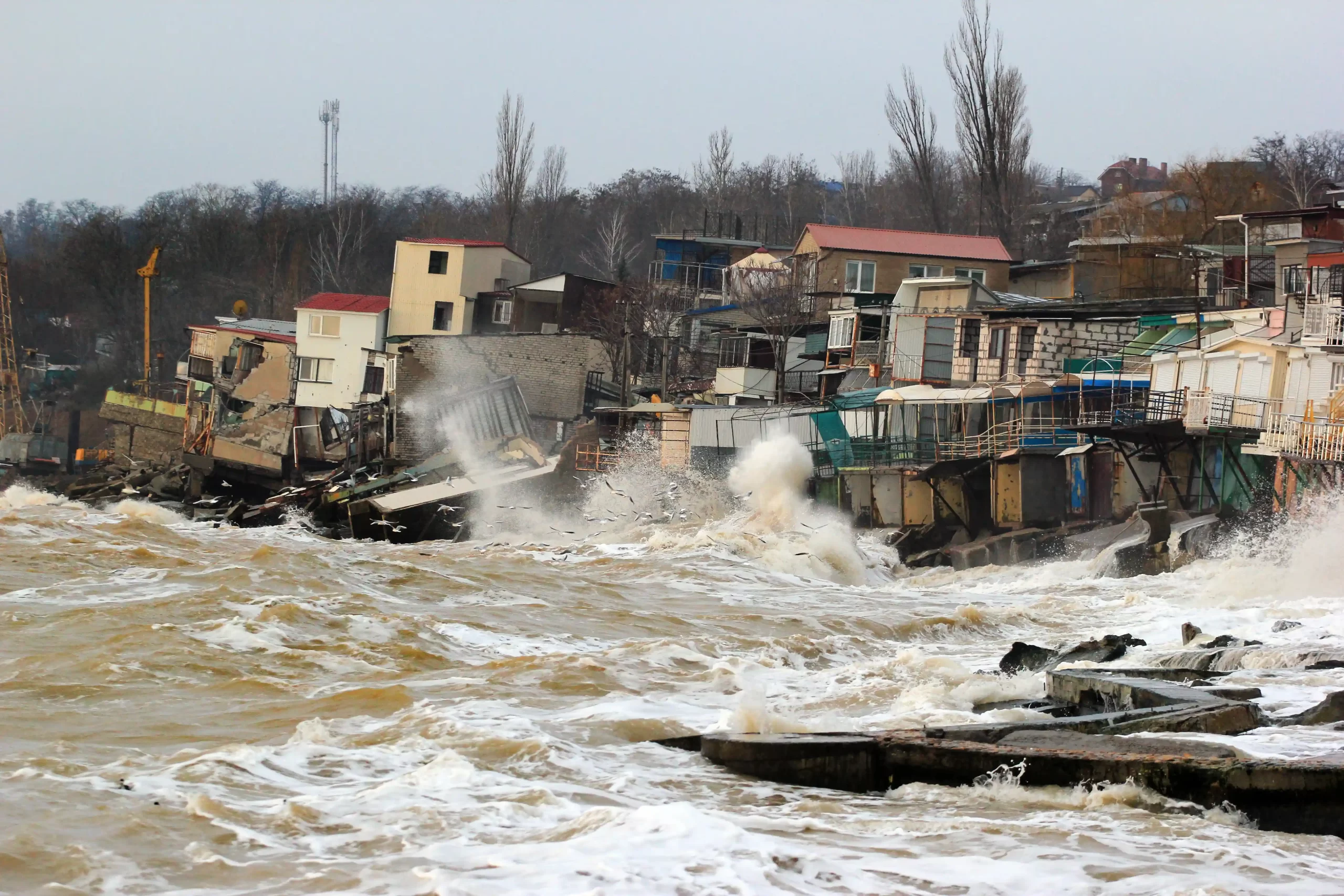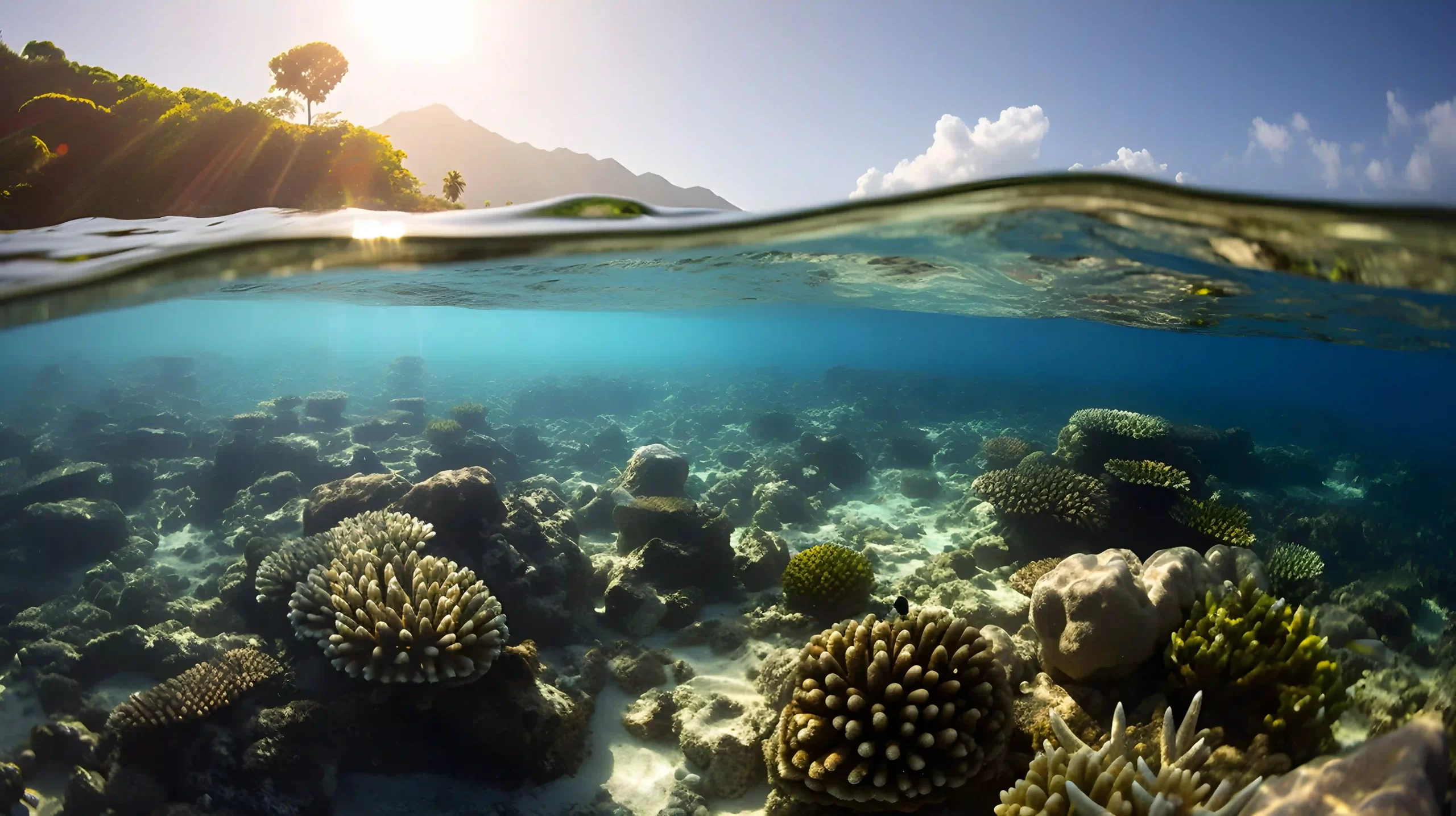The sea is crucial. Like us humans, the body of the Earth is mostly made up of water; to say it keeps things ticking over would be an understatement.
We’ve talked before about the significance of clean marine water, but what about ocean temperatures? Like every other natural habitat, a fine balance is needed to maintain a healthy ecosystem. And when the planet’s water is relied upon for so much, the effects are deeply felt when that balance is knocked out of whack.
Here, we wanted to tackle a key part of that balance in the form of sea water temperature. Are sea temperatures going up? What’s global warming got to do with it? And, crucially, what impact does this have on the planet and on us?
Read on to find out more or, if you prefer, use the index below to navigate through this guide:
- Are sea temperatures rising?
- How is global warming affecting water temperature?
- The impacts of sea surface temperature
- The significance of marine temperature monitoring
Are sea temperatures rising?
The average daily surface sea temperature has been on the rise since records began around 1985. See the thick black line on this graph by NOAA for a view of 2023’s temperatures.

https://climatereanalyzer.org/clim/sst_daily/
Birkel, S.D. ‘About Climate Reanalyzer’, Climate Reanalyzer (https://ClimateReanalyzer.org), Climate Change Institute, University of Maine, USA. Accessed on 18/06/2023.
As Professor Matthew England, a climate scientist at the University of New South Wales said in an article from the Guardian, “The current trajectory looks like it’s headed off the charts, smashing previous records.”
While an average temperature increase per decade of around 1 degree Farenheit might not seem like much, it becomes clearer how dramatic this is when you consider the ocean’s vastness. About 71 percent of the Earth’s surface is covered in water. That’s roughly 332,500,000 cubic miles of water.
Now think about how long it takes to boil your kettle. A few long, dragging minutes, all to boil enough for a few cups of tea. That is, it takes so much energy to boil a litre of water that it takes minutes to do so.
Considering the enormity of the ocean, an average temperature increase of 1 degree per decade means the ocean has to be absorbing so much more energy than it usually would – and this is quite frightening. But why? And why is it happening in the first place?
How is global warming affecting water temperature?
The biggest contributors to ocean warming are our general acceleration of climate change and greenhouse gas emissions.
The beginning of the Industrial Revolution a few hundred years ago marked the start of our excessive use of fossil fuels. Along with industrialisation came deforestation and the annihilation of many natural carbon-capturing environments.
All of this amounts to a huge increase in greenhouse gas (carbon dioxide, methane, etc) emissions and heat being pumped into the Earth’s atmosphere. In 2019, for example, CO2 levels in the atmosphere were higher than at any time in at least 2 million years.
Greenhouse gases form something of a blanket around the planet, trapping extra heat nearer the Earth’s surface, causing temperatures to rise. This is known as the greenhouse effect.
Of course, not all of the heat we have ever produced stays within the atmosphere, but it does have a huge impact – and that heat has to go somewhere. In fact, much of this heat is absorbed into the planet’s oceans.
Though the ocean is a natural carbon sink, it can’t keep up with humanity’s rising emissions. As a result, it will continue to heat up exponentially unless something changes – and soon.
Climate change as a natural phenomenon
Climate change in and of itself is, indeed, a ‘natural phenomenon’ – but we want to make some definitions very clear here. In its natural form, climate change describes long-term shifts in temperatures and weather patterns. The Ice Age, which came on incredibly slowly, can be described as a period of climate change.
Research shows that for the last 2.6 million years, the earth has been alternating between long ice ages and shorter interglacial periods. These generally happen around every 100,000 years – so typically, that’s 90,000 years of ice age and then a 10,000-year interglacial (warmer) period.
We’re currently in an interglacial period known as the Holocene and, for the last 2,000 years, the earth’s climate has been relatively mild and stable. Or at least it was, until humanity began speeding up climate change.
The Intergovernmental Panel on Climate Change has stated that, “Since systematic scientific assessments began in the 1970s, the influence of human activity on the warming of the climate system has evolved from theory to established fact.”
The El Niño Southern Oscillation

We can’t talk about rising sea water temperatures without mentioning the El Niño Southern Oscillation – also known as ENSO – which occurs in the Pacific Ocean.
This vast expanse of water experiences consistent east-to-west trade winds, which drive warm surface waters towards the western side of the ocean (around Asia and Australasia). Meanwhile, colder waters ‘upwell’ along the coasts of South and Central America.
Warmer waters in the west release additional heat into the air, causing it to rise more vigorously, resulting in unsettled weather – with increased cloud cover and rainfall. Cooler, drier air descends on the eastern side. It is this circulation which reinforces the easterly winds. In this way, the region maintains a self-perpetuating equilibrium until the arrival of El Niño.
Tropical Pacific weather systems can trigger a sequence of events that weaken or reverse the prevailing wind direction. This leads to a reduction in the amount of warm water being pushed towards the western side and, therefore, less upwelling of cold water on the eastern side. Typically colder ocean regions become warmer and the area of unsettled weather shifts.
These changes in large-scale wind patterns have far-reaching effects on global temperatures and rainfall, particularly in the tropical regions, with increased occurrences of floods and droughts in areas like Indonesia.
Subsequently, the region’s climate undergoes a reverse phase called La Niña, known as the cold phase of the ENSO.
What’s ENSO got to do with climate change?
It’s the phenomenon that eats itself: El Niño contributes to the rise in global temperatures, which, in turn, perpetuates the warming of the ocean.
Climate models suggest that future El Niño events may become more frequent and intense due to the impact of rising global temperatures, potentially exacerbating the overall warming trend.
The latest La Niña (cold) phase, which occurred between 2020 and early 2023, saw surprisingly warm sea temperatures. As the phase concludes, it becomes increasingly evident that the rising sea temperatures we are witnessing serve as a significant indicator of global warming.
Prior to 2023, the hottest global sea temperatures were recorded during El Niño (the hot phase) between 2014 and 2016. However, a recent milestone was reached on April 5, 2023 – outside of El Niño – as the average daily sea temperature soared to 21.1 degrees Celsius, breaking previous records.
The impacts of sea surface temperature
So we know the causes of sea temperature warming. But what does it matter? A few degrees here and there would make for more comfortable swimming, right?
Unfortunately, like many phenomena caused by global warming, there’s more nuance to it than that. These degrees of warming can have devastating impacts on marine life, weather patterns, and land temperatures – all of which affect us humans, so let’s take a closer look.
Aquatic ecosystems
Animal species tend to be well-evolved for their particular environment. When that environment changes – even subtly – they often cannot adapt quickly enough. This is what’s happening underwater as temperatures change.
To put it simply, as water temperatures increase, the amount of oxygen it can contain decreases. Ultimately, this means that less oxygen is available for fish.
Because of their reduced aerobic capacity in these conditions, some fish species have been known to relocate to waters with cooler temperatures, leaving their ‘home turfs’. As you might imagine, this can be bad news for the original ecosystems, which are often predicated on a delicate balance of predators and prey.
Professor Shaun Killen, senior author of a University of Glasgow study on the topic said, “If the prey of these species don’t also move, or if these species become an invasive disturbance in their new location, there could be serious consequences down the road.”
To be clear, those serious consequences could ultimately include the extinction of certain species and, in turn, the loss of carbon-capturing plant-life. Evidently, rising sea temperatures have an impact on aquaculture as an industry and source of food in the global food web.
It’s also important to note that hotter oceans contain more carbon dioxide — increasing levels of which lead to something called ‘ocean acidification’. This acidification threatens corals, snails, clams, mussels, and other marine life (typically, by dissolving their shells).
Cyanobacteria
While many fish don’t cope under rising temperatures, something else does: cyanobacteria. This microscopic filamentous bacteria uses nitrogen and phosphate to develop ‘blooms’ of organic matter in the form of blue-green algae. And what does blue-green algae do? Its large surface ‘mats’ limit the light levels that can enter the water, eventually starving an area of oxygen. All in all, BGA is bad news.
Coral reefs
You’ll likely have heard of the coral reef crisis. You’ll have seen the side-by-side pictures of now-white coral reefs next to ones teeming with life in times gone by.
Not all coral reefs are dead – but many are dying, and ocean warming is playing a huge role in their destruction. In fact, only one degree celsius of warming can have a significant effect, causing them to “bleach”.
To add insult to injury, scientists estimate that if the temperature increase continues on its current trajectory, oceans will be too warm for coral reefs by 2050.
Ice melting
As sea water heats up, polar ice caps melt. This results in freshwater being added to the surrounding waters, reducing the saltiness of the sea — which impacts saltwater species that rely on sustained salt levels.
Weather patterns
There is evidence to show that rising sea temperatures have an impact on weather patterns around the globe.
For one, this general trend has been shown to result in an increase in the speed and intensity of storms. A study by Bhatia et al states: “Specifically, areas with the largest increase in sea surface temperatures (SSTs) and potential intensities appear to be collocated with the largest positive changes in intensification rates.”
The ocean, in its enormity, powers weather patterns by driving evaporation and precipitation cycles. As temperatures on the water’s surface increase, so too does the rate of evaporation, adding additional moisture to the atmosphere. As we learned in school, evaporation leads to precipitation i.e. rain! And lots of it.
Wetter areas will experience yet more precipitation, and already-dry regions become drier. As a result, these areas are set to experience more prolonged droughts and are at higher risk of wildfires.
Not only this, but the saltiness and temperature of the ocean drive ocean currents, which are then disrupted by melting ice and rising temperatures. This leads to yet more intense weather, like hurricanes, flooding (more on this in a moment), and tropical storms.
Land temperatures & sea levels

It’s strange to think about, but when water heats up, it expands. You might’ve heard that the cause of cracks in roads in winter is not the ice that settles there, but the thawing process that causes the ice to expand and put pressure on the tarmac. This process is known as thermal expansion.
Effectively the same thing is happening on the oceanic scale. In fact, about 40% of global sea level rise over the past few decades has been put down to thermal expansion – not simply melting polar ice caps.
As perhaps one of the most severe impacts of climate change, sea level rise (SLR) threatens to swallow up small-island nations and erode coastal regions. It’s already doing so, destroying not only communities but habitats for fish, birds, and plants. Not only does SLR strip areas away over time, but contributes to more powerful storm surges, floods, and hurricanes that do so overnight.
Furthermore, as sea water rises, salt contaminates agricultural soil and underground aquifers that we rely on for drinking water.
The significance of marine temperature monitoring
What does all of this add up to? A frankly unsustainable trajectory. To see the damage climate change is causing, we need only look to the sea.
As Dr Kevin Trenberth, a co-author and scholar at the US National Center for Atmospheric Research, puts it, “The best indicator of the planet’s warming is the global ocean heat content.”
It follows, then, that sea temperature monitoring is an absolutely necessary part of the solution. Excellent projects are being undertaken around the world to get a well-rounded picture of this, and we hope a sustained effort here continues.
What we do with this data – the actions we translate it into – will directly affect the future of life on earth. Not just at a vague point in the future, out of sight of our lifetimes, but now – in our lifetimes and those of our children.
__________________________________________________________
For accurate, simplistic, robust water quality monitoring, you can rely on Aquaread. Our temperature sensor comes as standard on many of our probes – see what’s available here.
Don’t forget to keep up with the Aquaread blog for more insights on all things water. If you liked this blog, you might be interested in ‘7 Ways We Can Stop Sea Pollution Together’!

